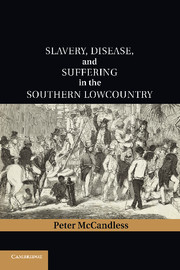Book contents
- Frontmatter
- Contents
- List of Figures
- List of Maps
- Preface
- Acknowledgments
- List of Abbreviations Used in Notes
- MAP 1 The Lowcountry, Charleston, and the Caribbean region
- MAP 2 The South Carolina lowcountry, showing Anglican parishes and slave proportion of population, c. 1760s
- MAP 3 Charleston Harbor, based on a British map, c. 1780
- MAP 4 The Revolutionary War in the South
- PART I TALK ABOUT SUFFERING
- PART II COMBATING PESTILENCE
- Bibliography
- Index
PART II - COMBATING PESTILENCE
Published online by Cambridge University Press: 03 May 2011
- Frontmatter
- Contents
- List of Figures
- List of Maps
- Preface
- Acknowledgments
- List of Abbreviations Used in Notes
- MAP 1 The Lowcountry, Charleston, and the Caribbean region
- MAP 2 The South Carolina lowcountry, showing Anglican parishes and slave proportion of population, c. 1760s
- MAP 3 Charleston Harbor, based on a British map, c. 1780
- MAP 4 The Revolutionary War in the South
- PART I TALK ABOUT SUFFERING
- PART II COMBATING PESTILENCE
- Bibliography
- Index
Summary
“Doctor, are you sure I'm suffering from pneumonia? I've heard once about a doctor treating someone with pneumonia and he finally died of typhus.” “Don't worry, it won't happen to me,” the doctor replied. “If I treat someone with pneumonia he will die of pneumonia.”
Joke of unknown originHe may rest satisfied that he will die neither of the dose nor the doctor, both which deaths are equally terrible, tho' the lot of many a poor man and unhappy woman.
Alexander Garden, 1761I wish no person would send for me, for I know nothing of this disease, and am as ignorant as a child unborn – for let me do as I will, puke, purge or bleed still they all die.
Alexander Baron, 1794- Type
- Chapter
- Information
- Slavery, Disease, and Suffering in the Southern Lowcountry , pp. 149 - 150Publisher: Cambridge University PressPrint publication year: 2011

